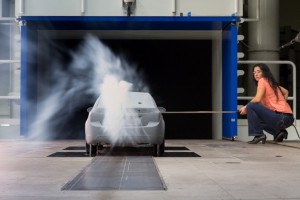
General Motors Aerodynamic Engineer Nina Tortosa tests underbody airflow on a Chevrolet Cruze 40% scale model.
General Motors is putting the finishing touches on a new $30 million wind tunnel for testing scale models on the campus of the GM Technical Center in Warren, Michigan, as part of its overall effort to meet tougher fuel-economy regulations that are looming over the next decade.
GM is also planning an overhaul of its full-size wind tunnel, which is adjacent to the new test center. The overhaul will begin late next year and will take about a year to complete, and will include the construction of a full-scale rolling road system and other improvements.
“The combined capabilities of our new reduced-scale and full-scale wind tunnels allow us to reach industry-leading levels of aerodynamic refinement,” said Ken Morris, vice president, GM Global Product Integrity.
Like other automakers, GM must meet new fuel-economy and emission standards in the U.S., Europe and East Asia that will require new, lighter vehicle designs, GM executives noted.
“We view the new $30 million reduced scale wind tunnel as an investment towards a better, more energy-efficient future,” he added.
Scott Miller, GM’s global director of carbon dioxide strategy, said finding ways to reduce the wind resistance and air turbulence around and beneath a vehicle, which improves every vehicle’s “coefficient of drag” is one of the most effective ways to improve fuel economy and reduce emissions of carbon dioxide. Every 12 “count” improvement in the coefficient of drag results in 1 mpg improvement in fuel economy, Miller noted.
The new Chevrolet Volt is now the vehicle with the lowest “cd” – 0.28 – in the GM fleet.
(Cadillac unveils new XT5 crossover at Dubai Motor Show. For more, Click Here.)
With the new wind-tunnel for scale models, GM is now able to accelerate and verify fuel-saving designs earlier in development of new cars and trucks, he added.
GM’s new, 35,000-square-foot Reduced Scale Wind Tunnel aerodynamically tests clay models up to 40% of the scale of a vehicle. It is equipped with a conveyor-style rolling road system that simulates real-world highway driving conditions up to a top speed of 155 mph. Testing reduced-sized vehicles on a simulated road allows GM aerodynamic engineers to reduce wind drag in a full-size vehicle design.
(Click Here for details about the Colorado getting the EPA nod on truck fuel economy.)
Advanced 3D printing machines create underbodies and engine blocks that are detailed and to scale for the reduced sized clay models. Working suspensions with spinning wheels allow aerodynamic engineers to better examine how airflow affects a vehicle’s underbody while in motion, resulting in quieter cars and trucks that can cost customers less to operate.
Test Engineer Jeff Bordner said using scale models 40% the size of the full-size vehicle helps engineers put more precise detail on each sculpted test vehicles.
(GM still bullish on diesel despite VW problems. Click Here for more.)
Miller also noted new aerodynamic test facility is located next to GM’s full-scale wind tunnel that has been in operation since 1980. Since it opened in 1980, the full-scale wind tunnel has helped GM boost the aerodynamic efficiency of its cars, trucks and utility vehicles by more than one third.
